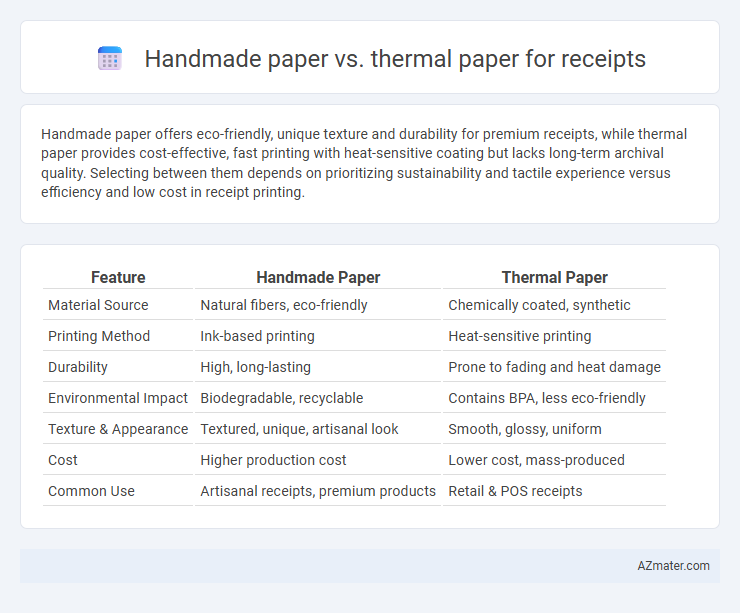Handmade paper offers eco-friendly, unique texture and durability for premium receipts, while thermal paper provides cost-effective, fast printing with heat-sensitive coating but lacks long-term archival quality. Selecting between them depends on prioritizing sustainability and tactile experience versus efficiency and low cost in receipt printing.
Table of Comparison
| Feature | Handmade Paper | Thermal Paper |
|---|---|---|
| Material Source | Natural fibers, eco-friendly | Chemically coated, synthetic |
| Printing Method | Ink-based printing | Heat-sensitive printing |
| Durability | High, long-lasting | Prone to fading and heat damage |
| Environmental Impact | Biodegradable, recyclable | Contains BPA, less eco-friendly |
| Texture & Appearance | Textured, unique, artisanal look | Smooth, glossy, uniform |
| Cost | Higher production cost | Lower cost, mass-produced |
| Common Use | Artisanal receipts, premium products | Retail & POS receipts |
Introduction to Receipt Paper Types
Receipt paper types primarily include handmade paper and thermal paper, each serving distinct purposes in transaction documentation. Handmade paper offers a textured, eco-friendly option valued for durability and aesthetic appeal, often used in specialty or artisanal receipts. Thermal paper, coated with heat-sensitive chemicals, enables fast, high-quality printing without ink, dominating retail and point-of-sale industries due to cost-effectiveness and efficiency.
What is Handmade Paper?
Handmade paper is created through traditional, labor-intensive methods using natural fibers such as cotton, hemp, or recycled rags, resulting in a textured, durable surface ideal for artisanal products and eco-friendly printing. Unlike thermal paper, which relies on heat-sensitive chemicals for image formation, handmade paper offers organic qualities and environmental benefits without the chemical coatings found in thermal receipts. Its unique, fibrous composition enhances print clarity for ink-based receipts, making it a sustainable and aesthetically distinct alternative for businesses emphasizing craftsmanship and green practices.
What is Thermal Paper?
Thermal paper is a heat-sensitive paper commonly used for receipts, which changes color when exposed to a thermal print head, eliminating the need for ink or toner. Unlike handmade paper, thermal paper offers quick, efficient printing with clear, sharp text ideal for point-of-sale transactions. Its smooth surface and chemical coating make it more durable and resistant to smudging compared to the textured, fibrous nature of handmade paper.
Production Process Comparison
Handmade paper production involves traditional techniques using natural fibers, water, and manual pressing, resulting in eco-friendly and textured receipts ideal for artisanal brands. Thermal paper manufacturing relies on chemical coatings and heat-sensitive layers applied in high-speed industrial processes, enabling quick and efficient printing without requiring ink. The distinct production methods impact durability, cost, and environmental footprint, with handmade paper offering sustainability and thermal paper emphasizing efficiency.
Environmental Impact: Handmade vs Thermal
Handmade paper used for receipts has a significantly lower environmental impact compared to thermal paper, as it is typically crafted from recycled fibers and biodegradable materials, reducing waste and pollution. Thermal paper, on the other hand, often contains BPA or BPS chemicals, which pose health risks and contribute to environmental toxicity when discarded. Choosing handmade paper supports sustainable forestry and decreases reliance on chemical-intensive manufacturing processes, promoting eco-friendly business practices.
Durability and Longevity
Handmade paper receipts offer superior durability due to thicker fibers and natural materials, making them more resistant to wear, moisture, and fading over time compared to thermal paper. Thermal paper relies on heat-sensitive coatings that can darken, fade, or become illegible when exposed to heat, light, or certain chemicals, significantly reducing its longevity. For environments requiring long-term receipt preservation, handmade paper provides a more reliable and lasting solution.
Cost Analysis: Handmade Paper vs Thermal
Handmade paper receipts typically incur higher production costs due to labor-intensive manufacturing processes and limited scalability compared to thermal paper, which benefits from automated mass production and lower material expenses. Thermal paper offers cost efficiency with lower unit prices and longer shelf life, reducing frequent reordering and operational downtime for businesses. Despite higher upfront costs, handmade paper may appeal to niche markets prioritizing sustainability and artisanal value, but thermal paper remains the dominant choice for cost-effective receipt printing.
Printing Methods and Compatibility
Handmade paper, with its textured and fibrous surface, typically requires specialized printing methods such as letterpress or embossing to ensure legibility, limiting compatibility with common thermal printers. Thermal paper, designed specifically for heat-sensitive printing, offers seamless compatibility with thermal receipt printers, producing crisp and clear prints without the need for ink. Selecting between handmade and thermal paper impacts printing efficiency and device compatibility, crucial for retail environments prioritizing speed and print quality.
Health and Safety Considerations
Handmade paper receipts are often free from harmful chemicals such as Bisphenol A (BPA) and Bisphenol S (BPS), which are commonly found in thermal paper and linked to endocrine disruption and other health risks. Thermal paper's sensitivity to heat and light can cause the printed chemicals to degrade, posing potential risks to skin contact and frequent handling. For safer options, businesses and consumers should prioritize BPA-free thermal paper or explore handmade paper receipts that avoid toxic compounds entirely, reducing health hazards.
Choosing the Right Paper for Your Business
Choosing the right paper for your business receipt printing impacts both cost-efficiency and customer experience. Handmade paper offers a unique, eco-friendly option with textured quality and durability, ideal for boutique shops emphasizing sustainability and brand identity. Thermal paper provides fast, cost-effective printing with clear, smudge-resistant receipts suited for high-volume retail and hospitality environments requiring quick transactions.

Infographic: Handmade paper vs Thermal paper for Receipt
 azmater.com
azmater.com